Join More Than 50,000+ Subscribers and get latest camera news and rumors
NEW CAMERA VIDEOS ON YOUTUBE
|
By admin, on February 25th, 2012
 Read the Canon G1 X vs. Nikon V1 vs. Panasonic GX1 review to find out the best camera for you. Read the Canon G1 X vs. Nikon V1 vs. Panasonic GX1 review to find out the best camera for you.
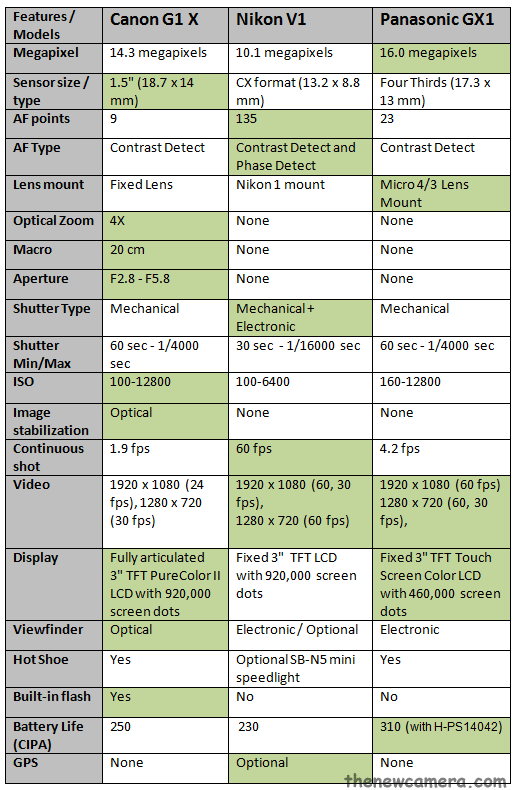
Sensor and image processor
Canon G1 X uses newly developed 1.5 inch 14.3 CMOS sensor with DIGIC V image processor, with the new sensor and image processor you get more dynamic range, better ISO range and less noise in your images.
Panasonic uses 16 megapixel M 4/3 sensor and venus FHD image processor, the Venus FHD processor is the same processor used in GH2 / GF2 / GF3 / G3 mirrorless cameras.
Nikon V1 uses a small CX format sensor but very fast Expeed 3 image processor, you get Continuous shot up to 60 Shot/Sec.
Noise Levels & Dynamic Range: Large sensors with larger pixels produce low noise and higher dynamic range.
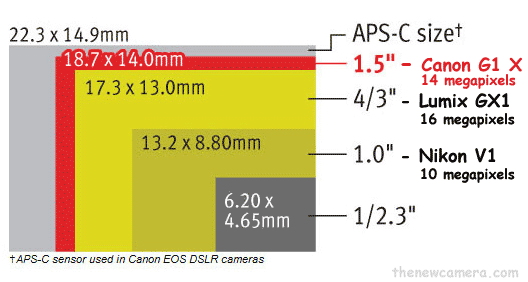
ISO: The ISO rating on Nikon 1 is limited to 6400, Panasonic Lumix GX1 ISO range is 160 to 12800 and Canon G1 X ISO range is 100 to 12800, the overall ISO range of Canon G1 X is better compared than the Nikon V1 and Panansonic Lumix GX1.
Auto Focus: Nikon V1 uses Hybrid AF system with both phase and contrast detection with 135 AF points, Panasonic GX1 features 23 AF point with contrast detection and Canon G1 X uses contrast detection AF system and comes with only 9 AF points
Shutter Speed – If we look at the type of shutter and image processor used in all these three camera, the Nikon V1 comes out as a clear winner
|
Shutter Type |
Continuous shooting |
Shutter |
| Min |
Max |
| Nikon 1 |
Mechanical + Electronic |
10 fps – Mech. Shutter60fps – Elect. shutter |
30 sec |
1/16000 sec |
| Lumix G1X |
Mechanical |
4.2 fps |
60 sec |
1/4000 sec |
| Canon GX 1 |
Mechanical |
1.9 fps |
60 sec |
1/4000 sec |
Lenses Many options available with Panasonic Lumix GX1, you get wide range of high quality optics including fast prime lenses.
The Canon G1 X comes with a compact 4X optical zoom lens, the Nikon 1 have very limited range of Nikon 1 Lenses.
Pocketable: Canon G1 X with fixed 4X optical Zoom Lens and Panasonic Lumix GX1 with collapsible kit zoom can easily fit in your jacket pocket, Nikon 1 lenses are big and need more space / travel bag.
Video: Both Nikon and Panasonic and Lumix offer Full HD Video recording at 60 fps, Canon G1 X Full HD video recording is limited to 30 fps only.
Display: The Canon G1 X comes with Fully articulated 3″ TFT PureColor II LCD with 920,000 screen dots, The Panasonic GX1 features with Fixed 3″ TFT Touch Screen Color LCD with 460,000 screen dots and finally Nikon V1 with Fixed 3″ TFT LCD with 920,000 screen dots.
View finder: Canon G1X features Optical viewfinder, Nikon V1 have Electronic viewfinder and Panasonic Lumix GX1 have optional Electronic viewfinder.
Conclusion:
Canon G1 X is the best compact camera ever made, highly recommended for event shooters, photojournalist, nature & Landscape photographers, In a very tight compact body you get 1.5inch sensor, ISO up to 12800 and high quality 4X optical zoom lens.
Panasonic GX1, Comes with bit smaller sensor compared GX 1 features better video mode and new X series of contractible zoom lens are highly optimized for video shooting, , with four third format you also get a wide range of high quality optics including fast prime lenses.
Nikon 1 system is highly recommended for sports & Action Photographers, it features advance AF system and continuous shooting up to 60fps, but remember the sensor size is small compared to Canon G1 X and Panasonic GX1 (you get limited dynamic and ISO range).
Buy Canon G1 X from Amazon || B&H |||
Buy Nikon V1 from Amazon || B&H ||| Amazon UK
Buy Panasonic GX1 from Amazon || B&H ||| Amazon UK
By admin, on February 16th, 2012
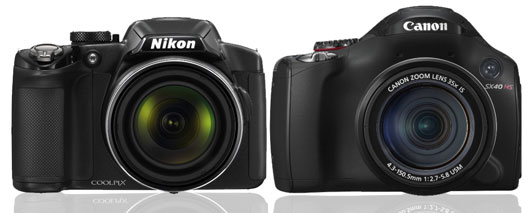
Nikon P510 vs. Canon SX40 HS specification comparison review, read the review before buying you next Super Megazoom Camera.
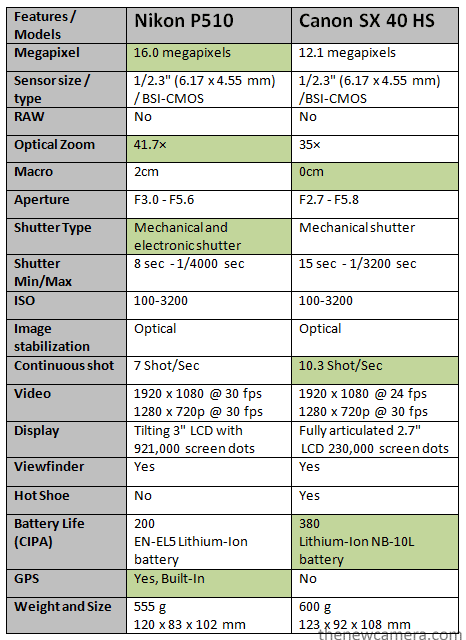
Optical Zoom and Lens Quality
Nikon features 41.7x optical zoom, Canon SX 40 HS limited to 35x only.
Canon features UD glass, double-sided aspherical glass-molded and ultra-high-refraction-index glass lens elements to effectively suppress chromatic aberration. The camera uses a VCM (Voice Coil Motor) for high-speed, quiet, energy-efficient lens movement with precise control.
Nikon P510 comes with Four ED glass elements minimize chromatic aberration.
Sensor: Nikon uses 16 Mp BSI CMOS sensor and Canon uses 12.1 Mp BSI CMOS sensor.
Canon SX 40 HS uses newly developed BSI CMOS sensor and DIGIC 5 image processor, the Canon SX40 HS also features advanced Multi-area White Balance optimizing color tones of both subject and background under multiple light sources.
Nikon P510 uses new Back-illuminated 16-MP CMOS sensor, you get more resolution than the Canon SX 40 HS.
Image Processor: Nikon P510 uses old Expeed 2 image processor, Canon uses new DIGIC V image processor.
Image processor of Canon is very fast, It can capture/process approx 10.3 shot/sec in high speed shooting mode, Nikon P500 is limited to 8 shot/sec only.
Image Stabilization: Both Canon SX 40 HS and Nikon P510 features optical Image Stabilization.
Canon SX 40HS features Hybrid IS System of Canon SX 40 HS features Six Intelligent IS Modes, Canon SX 40 HS automatically chooses from six different modes (Normal, Macro, Panning, Dynamic, Powered, Tripod) to optimize image stabilization and help achieve crisp, blur-free images for various shooting conditions.
Nikon P510 features second generation vibration reduction system to combat camera shake.
Shutter: Nikon P510 uses Mechanical and electronic shutter, canon uses Mechanical only.
Nikon P510 comes with Mechanical and electronic shutter, you get Maximum shutter speed up to 1/4000, Canon comes with Mechanical shutter and the speed is limited to 1/3200. The Min shutter speed of Canon is 15 sec and Nikon is 8 sec only.
Movie Mode: Both Nikon and Canon offers Full HD Video recording and AF during Video mode.
GPS: Nikon P510 comes with Built-In GPS, Canon SX 40 HS have no GPS.
Display: Practically I like Canon vari-angle display, but Nikon Wins here, Nikon P510 features 3″ Tilting Screen with 921,000 screen dots and Canon comes with fully articulated 2.7″ LCD with 230,000 Screen dots.
Battery Life: Canon SX40 HS battery life is approx double than the Nikon P510.
Overall Conclusion:
Buy Nikon P510 if you want to have Super Megazoom Camera (42X optical zoom), more resolution(16Mp sensor), better display and In-Built GPS.
Buy Canon SX40 HS if you want better IS system, fast image processor (with less noise), bright (F2.7) lens, High speed burst mode (10.3 fps) and longer battery life.
Buy Nikon P510 from – Amazom || B&H || Adorama
Buy Canon SX 40 HS from: Amazon || Amazon UK || Adorama || B&H
By admin, on February 12th, 2012
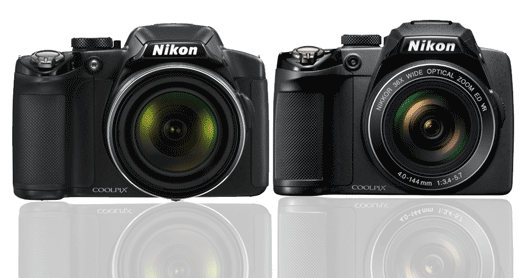
New in Nikon P510: Nikon P510 have astounding 24–1000mm (42X optical zoom) wide-angle to super telephoto zoom lens, more megapixel, Mechanical and electronic shutter and GPS. Read the specification comparison review below for more details
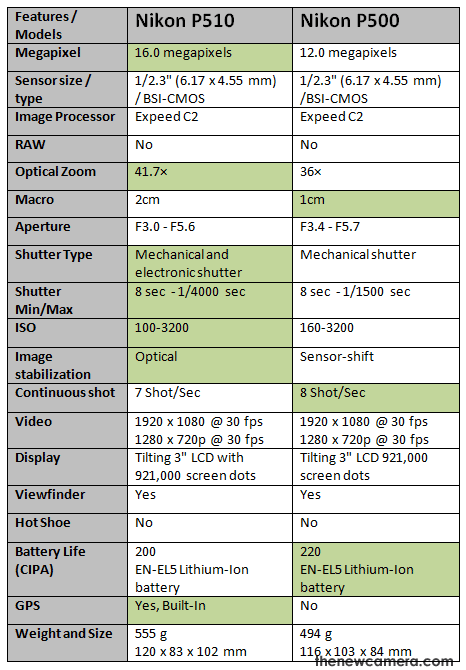
Nikon P510 vs. Nikon P500
Nikon P510 features 42X optical Zoom and Nikon P500 36X only: Nikon P510 is the only digital camera available in the world that features 42X optical zoom, Nikon P510 comes with Four ED glass elements minimize chromatic aberration,
New 16 megapixel BSI CMOS sensor , Nikon P510 comes with new 16 Megapixel BSI CMOS sensor whereas P500 have 12 Megapixel BSI CMOS sensor, you get more resolution however both the camera have same sensor size.
Expeed 2 Image processor : Image processor still remains the same, Nikon uses its old Expeed 2 image processor in Nikon P510.
Fast and accurate AF: when you want to capture complex subjects, you can shoot in manual focus with a 99-point autofocus system for extra-sharp results.
Image Stabilization: Nikon P510 have advanced lens-shift vibration reduction system, better than the sensor shift system of Nikon P500
Introduction of electronic shutter in Nikon P510
Nikon P510 is the first Nikon Superzoom compact camera to feature Mechanical and electronic shutter, due to the introduction of electronic shutter you get shutter speed up to 1/4000.
The Nikon P510 also features Auto HDR, the camera combines two shots taken at different exposures during a single shutter release to create an image with wide dynamic range and rich color gradation.
The picture control of Nikon P510 was not available in Nikon P500, the Coolpix Picture Control can be used in all four exposure modes – [P] programmed auto, [A] aperture-priority auto, [S] shutter-priority auto, [M] manual mode.
GPS: New Nikon P510 is also the first Megazoom camera to feature In-Built GPS.
Battery: Same as P500, EN-EL5 Lithium-Ion battery
Nikon P510 can do Wireless transfer: compatible with Eye-Fi X2 (or later) cards. Transmit your digital photos (in JPEG format) directly to your phone or personal computer.
Buy Nikon P510: Nikon P510 is the only Megazoom camera to feature 42X optical zoom, 16Mp BSI CMOS sensor and high shutter speeds, Highly recommended.
Buy Nikon P510 from – Amazom || B&H || Adorama
Support New Camera Buy Music CD or Digital Camera at amazon it helps this site, and you do not pay anything extra, it is just a way to help support this site.

By admin, on January 22nd, 2012
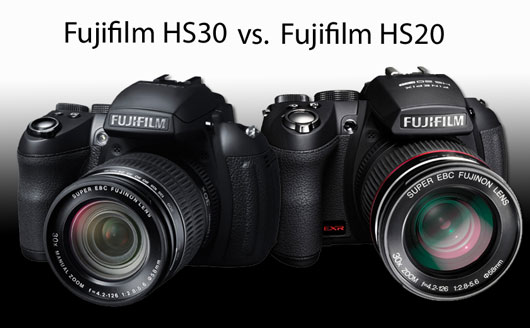 Fujifilm HS30 EXR vs Fujifilm HS20 EXR, fujifilm HS30EXR includes a number of key specification improvements over the HS20EXR model it replaces. Read the specification comparison review below and share your thoughts with us Fujifilm HS30 EXR vs Fujifilm HS20 EXR, fujifilm HS30EXR includes a number of key specification improvements over the HS20EXR model it replaces. Read the specification comparison review below and share your thoughts with us
Buy Fujifilm HS30 from Amazon
Buy Fujifilm HS20 from Amazon
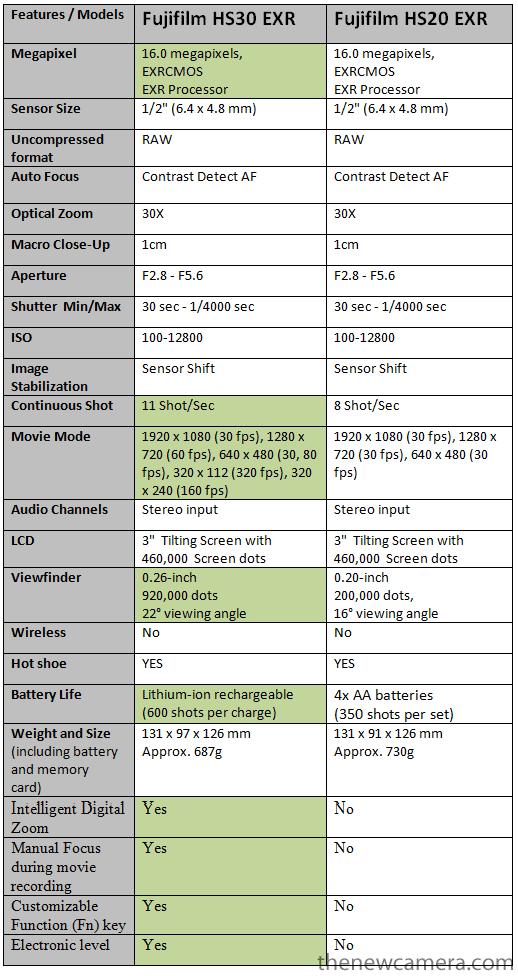
FinePix HS30EXR features an improved EXR-CMOS sensor, By redesigning the shape of the photo diodes used in the EXR-CMOS sensor, the images display 30% less digital noise at higher ISO settings, which results in smoother tones and better low light images.
The Electronic Viewfinder (EVF) has been greatly improved.
New Lithium-ion rechargeable battery delivers up to 600 pictures per charge.
New EVF : Fujifilm HS30 EXR features same EVF as Fujifilm X S1, FinePix HS30EXR’s EVF have large display unit of 0.26-inche and features 920,000 dots, compared to only 200,000 dots on the HS20EXR, making for a far clearer viewing image.
Writing Speed: The writing period after continuous shooting has also been dramatically cut to approximately 2 seconds (compared to 20 seconds on the HS20EXR).
New Intelligent Digital Zoom function: This doubles the focal range, delivering a massive 60x zoom (30XDigital + 30XOptical) with a maximum telephoto setting of 1440mm.
In the new Fujifilm HS30 EXR you get customisable Function (Fn) key to assign shortcut and New HS30 EXR supports manual focus during movie recording.
Conclusion: Upgrade is recommended, Fujifilm HS30EXR comes same 30X optical zoom but features new sensor, faster processing power and better battery life..
Buy Fujifilm HS30 from Amazon
Buy Fujifilm HS20 from Amazon
Support New Camera Buy Music CD or Digital Camera at amazon it helps this site, and you do not pay anything extra, it is just a way to help support this site.

By admin, on January 20th, 2012
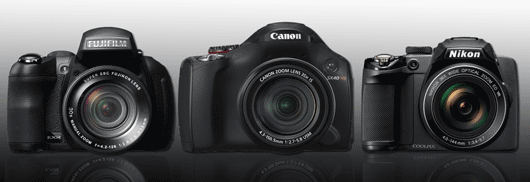
Fujifilm HS30 vs. Canon SX40 HS vs. Nikon P500 specification comparison review, read the review below and select your best megazoom camera.
Buy Fujifilm HS30 from Amazon
Buy Canon SX40 HS from Amazon
Buy Nikon P500 from Amazon
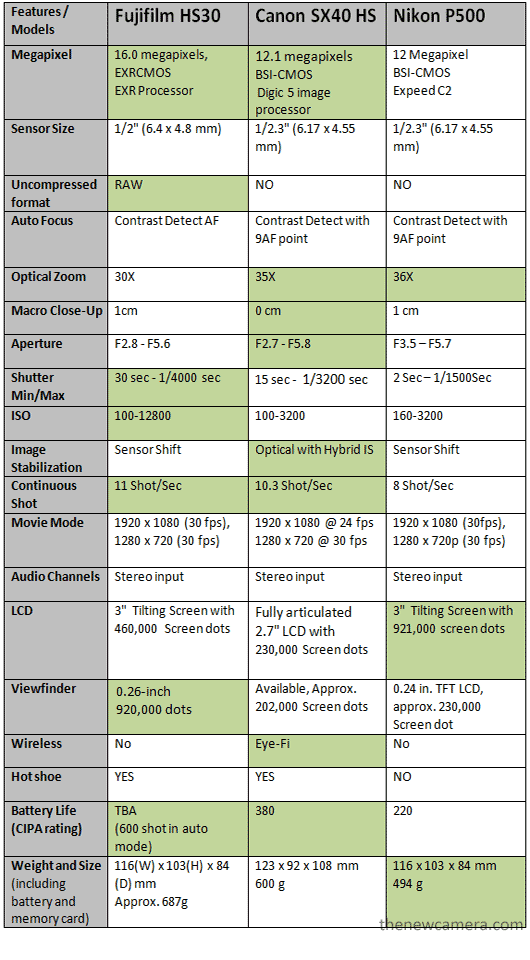
Sensor and image processor:
Fujifilm claims that HS30 uses new sensor, by redesigning the shape of the photo diodes used in the EXR-CMOS sensor, the images display 30% less digital noise at higher ISO settings (compared to HS20 @ ISO 3200), which results in smoother tones and better low light images.
Canon SX 40 HS uses newly developed BSI CMOS sensor and DIGIC 5 image processor, the Digic 5 image processor creates 75% less noise and 6X faster compared to Digic 4 image processor, Due to new sensor and image processor you get more details and less noise in high ISO settings.
Multi-area White Balance in SX 40 HS: The Canon SX40 HS features advanced Multi-area White Balance optimizing color tones of both subject and background under multiple light sources.
Nikon P500 comes with a BSI CMOS sensor but uses old expeed 2 image processor.
Image Processor: Image processor of both Canon and Fuji are very fast, both can capture approx 10.3 / 11 shot/sec in high speed shooting mode, Nikon P500 is limited to 8 shot/sec only.
RAW: Fuji is a clear winner on RAW mode, Only Fujifilm HS30 features RAW format capture.
IS Image Stabilization
| |
Fujifilm HS30 EXR |
Canon SX 40 HS |
Nikon P500 |
| Image Stabilization |
Sensor Shift + High ISO |
Optical |
Sensor Shift and VR |
| IS Modes(Hybrid IS) |
Not Available |
Available (Normal, Macro, Panning, Dynamic, Powered, Tripod) |
Not Available |
Fuji (CMOS shift + High ISO) Fuji HS30 uses sensor shift and High ISO modes to prevent camera shake.
Canon SX 40HS features 6 IS Modes and Optical IS The new Hybrid System of Canon SX 40 HS features Six Intelligent IS Modes, Canon SX 40 HS automatically chooses from six different modes (Normal, Macro, Panning, Dynamic, Powered, Tripod) to optimize image stabilization and help achieve crisp, blur-free images for various shooting conditions
Nikon features Image sensor shift(not optical) + electronic vibration reduction (VR) function
Images captured with image sensor shift vibration reduction enabled are further processed with electronic VR for images that are sharper and exhibit less blur.
Lens and Aperture Range
| Camera / Specification |
Fujifilm HS30 EXR |
Canon SX 40 HS |
Nikon P500 |
| Optical Zoom |
30X |
35X |
36X |
| Macro |
1cm |
0 cm |
1 cm |
| Aperture |
F2.8 – F5.6 |
F2.7 – F5.8 |
F3.5 – F5.7 |
Based on lens quality, aperture and optical zoom range canon SX 40 HS is a clear winner,
Canon features UD glass, double-sided aspherical glass-molded and ultra-high-refraction-index glass lens elements to effectively suppress chromatic aberration while maintaining a remarkably compact size. The camera uses a VCM (Voice Coil Motor) for high-speed, quiet, energy-efficient lens movement with precise control.
Similarly as canon, Fuji features high optical performance glass lens elements (aspherical, high refractive index, and ED glass lenses) make the exceptional brightness of F2.8 at wide angle and F5.6 at telephoto possible.
Nikon P500 features 36x Zoom and NIKKOR ED glass.
Shutter Speed
You get more range in shutter speed in Fujifilm HS30 compared to SX 40 HS or Nikon P500.
| Shutter Speed |
Fujifilm HS30 EXR |
Canon SX 40 HS |
Nikon P500 |
| Max |
4000 Sec |
3200 Sec |
1/1500 Sec |
| Min |
30 Sec |
15 Sec |
2 Sec |
| Continuous Shot |
11 Shot/Sec |
10.3 Shot/Sec |
8 Shot/Sec |
Movie Mode
All the three Megazoom camera offers Full HD Video recording and AF during Video mode. Fuji offers Full HD at 30 fps, Canon Full HS at 24 fps and Nikon Full HD at 30 fps.
Display:
Practically I like Canon vari-angle display, but Nikon Wins here, Nikon P500 features 3″ Tilting Screen with 921,000 screen dots and Fully articulated 2.7″ LCD with 230,000 Screen dots.
Viewfinder:
Fuji features a 0.26-inch superb high resolution viewfinder (approx. 920,000 screen dots) with eye sensor.
Batter Life
No CIPA rating currently available for Fuji HS30, but Fuji claims you can take 600 shots at auto with the new Lithium-ion rechargeable battery, Canon SX 40HS CIPA rating is 380 and Nikon P500 CIPA rating is 220.
Price
| Camera Models |
Fujifilm HS30 EXR |
Canon SX 40 HS |
Nikon P500 |
| Price (List Price) |
$499 |
$399 |
$320 |
Overall Conclusion: Nikon P500 is the most affordable megazoom camera, however according to specification, both canon and Fuji are better than the Nikon P500, Fuji HS30 zoom lens is limited to 30X but features RAW format and ISO range up to 12800, whereas canon SX 40 HS features 35X Zoom Lens with excellent optics and Hybrid IS.
Buy Fujifilm HS30 from Amazon
Buy Canon SX40 HS from Amazon
Buy Nikon P500 from Amazon
Support New Camera Buy Music CD or Digital Camera at amazon it helps this site, and you do not pay anything extra, it is just a way to help support this site.

By admin, on January 14th, 2012
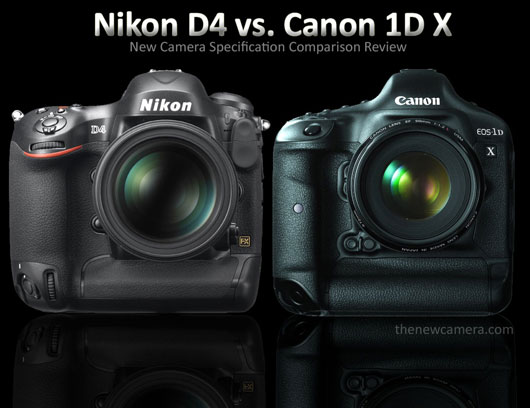
Canon 1D X vs Nikon D4 Specification comparison review, read more details below
Buy Nikon D4 from Amazon
Buy Canon 1D X from Amazon
 Nikon D4 with More shooting modes: With Canon 1D X you can use Canon EF lenses only, but with Nikon D4 you can use DX and FX lenses, Nikon D4 offers four image area options: FX format (36.0 x 23.9 mm), 5:4 crop (29.9 x 23.9 mm), 1.2x crop (29.9 x 19.9 mm) and DX format (23.4 x 15.5 mm). The camera also offers three image area options for Full HD video thereby tripling its potential for moviemaking. Nikon D4 with More shooting modes: With Canon 1D X you can use Canon EF lenses only, but with Nikon D4 you can use DX and FX lenses, Nikon D4 offers four image area options: FX format (36.0 x 23.9 mm), 5:4 crop (29.9 x 23.9 mm), 1.2x crop (29.9 x 19.9 mm) and DX format (23.4 x 15.5 mm). The camera also offers three image area options for Full HD video thereby tripling its potential for moviemaking.
About the Sensor: Nikon D4 features 16.2 megapixels Full frame (36 x 23.9 mm) CMOS Sensor and Canon 1D X 18.1 megapixels Full frame (36 x 24 mm) CMOS Sensor , the EOS-1DX’s photodiodes are 21% larger than those in the 1Ds Mark III.
ISO performance:
|
Nikon D4 |
Canon 1D X |
| ISO Standard |
100-12,800 |
100-51,200 |
| ISO Expandable |
50-204,800 |
50 – 204,800 |
According to the specification, for low light situation Canon 1D X is better, you get two extra stops of Standard ISO range.
Auto Focus
|
Nikon D4 |
Canon 1DX |
| Autofocus |
Number of focus points 51 |
Number of focus points 61 |
| Cross-Type Points |
15 |
41 (5 diagonal) |
| AF Sensor compatible with Apertures |
f/8 |
f/5.6 |
| AF Engine |
Multi-CAM 3500FX (same as D3) |
DIGIC IV |
| Predictive tracking |
Yes |
Yes |
Auto focus Points: The number of AF points and Cross/Type points canon wins, the Canon 1D X features 41 AF cross type points and 5 of the center points are oriented diagonally for faster AF performance.
Update: With the Latest Firmware Update Canon 1DX Now Support F8 Lenses – see details here
AF Points compatible with Apertures
- Canon 1D X is disappointing to many extender users. AF is unavailable on the EOS-1D X when lenses with a maximum aperture of f/8 are used.
- In Nikon D4 11 focus points are fully functional when lenses with a maximum aperture of f/8 are used. Five central focus points and three points to the left and right of them in the middle line are compatible with f/8. This enables very precise focus acquisition with sports photography and the like when super-telephoto NIKKOR lenses are used with a teleconverter (2.0x) at a combined aperture value of f/8.
F8 Lens: adding a 1.4x extender to an f/5.6 max aperture lens results in an f/8 max aperture lens or adding a 2x extender to an f/4 max aperture lens results in an f/8 max aperture lens.
AF Engine: Canon 1D X AF system uses dedicated Digic 4 processor , EOS-1D X’s comes with 61-point Area AF system that includes 41 cross-type sensors and 5 dual-cross type AF points for extra precision.
Nikon D4 features same (old) AF engine used in D3 DSLR – Multi-CAM 3500FX autofocus sensor handles 51 AF points, aligns its 15 cross-type sensors in the central viewfinder area to detect contrast in both vertical and horizontal lines for better AF performance.
Predictive tracking: Both features Predictive tracking Canon 1D X Predictive tracking is better, read the details below
Nikon D3 / D4 AF Engine Multi-CAM 3500FX capable of maintaining accurate focus even on a high-speed subject such as an F1 racing car traveling in excess of 300km/h.
However, simple predictive tracking AF does not provide maximum focusing performance for a subject that abruptly changes direction moving at high speed or a subject with low contrast moving randomly. To focus accurately on such a subject, the AF system must accumulate data of the locus of the subject’s movement using multiple focus areas so that appropriate judgment can be made.
Canon 1D X offers six presets for different shooting situations, Each of these presets can be adjusted for ‘Tracking sensitivity’
For faster predictive focus measurements so that the EOS-1D X can begin predictive tracking as soon as a subject begins to move.
| Canon EOS-1D X AF mode presets, defined by subject behavior: |
| 1. Versatile multi purpose |
4. Subjects that accelerate or decelerate quickly |
| 2. Continue shooting, ignore obstructions |
5. Erratic Subject Movement |
| 3. Instantly refocus suddenly with obstructions |
6. Subjects that change speed and move erratically |
Six preset Case studies
There are six AF ‘Case studies’ preset within the EOS-1D X
- Case 1 is for general purpose shooting that provides accurate and fast focus across a wide range of shooting situations.
- Case 2 is designed for situations where the subject may move away from the AF point momentarily.
- Case 3 allows you to instantly focus on subjects that enter the AF point area.
- Case 4 is designed for subjects that change speed or direction rapidly.
- Case 5 is designed for use with automatic AF point selection, Zone AF and AF Point expansion and subjects that move erratically, up and down or left and right.
- Case 6 is for subjects that change speed abruptly and move erratically. Like ‘Case 5’ it is used with Automatic AF point selection, Zone AF and AF Point Expansion.
Continuous shooting
|
Nikon D4 |
Canon 1D X |
|
exposure and focusing is locked with the first frame
|
| Continuous shooting |
11 fps |
14 fps |
1DX that wins in the shooting speed, you get 3 extra frame per second in canon.
Video Shooting
|
Nikon D4 |
Canon 1D X |
| Video Shooting Format |
MPEG-4 / H.264 |
MPEG-4 / H.264 |
| Video Resolutions |
1920 x 1080 (30, 25, 24 fps), 1280 x 720 (60, 50, 30, 25 fps), 640 x 424 (30, 25 fps) |
1920 x 1080 (30, 25, 24 fps, 1280 x 720 (60, 50 fps), 640 x 480 (60, 50 fps) |
| Video ISO Range |
200-204800 |
100-51200 |
Both Canon 1DX and Nikon D4 captures Full HD movie @ 30, 25, 24 fps, but with Nikon you get more options such use of expandable ISO range in video shooting and you can record 1,920 x 1,080/30p Full HD and HD movies in three formats that are FX-, DX-based and 1,920 x 1,080 crop movie format.
Storage: 1DX coming with two slots of high-speed UDMA 7 Compact Flash cards, D4 also comes with two slots one for UDMA 7 and the other slot for the new XDC card format.
Price: Nikon D4 cost $800 less than the Canon 1D X.
Conclusion: Canon 1DX have more advance core specification than the Nikon D4, But Nikon D4 is more versatile and Canon 1D X have some limitations.
Canon 1 DX offers more advance AF system, Canon used dedicated DIGIC IV processor as AF engine and Dual DIGIC5+ image processor for image processing, you also get two extra stops of Standard ISO range.
But, AF is unavailable on the EOS-1D X when lenses with a maximum aperture of f/8 are used. (ex adding a 1.4x extender to an f/5.6 max aperture lens results in an f/8 max aperture)
Nikon D4 used same AF engine as used D3 and only single core Expeed 3 processor is used for processing images, But Nikon D4 is more versatile, It offers crop mode still and video shooting and you canon use FX and DX lenses in D4. No F8 issue, In Nikon D4 11 focus points are fully functional when lenses with a maximum aperture of f/8 are used. Nikon D4 offers iPad and iPhone wireless shooting capability, you also get a new slot for new memory card format (XQD).
Buy Nikon D4 from Amazon
Buy Canon 1D X from Amazon
By admin, on December 15th, 2011
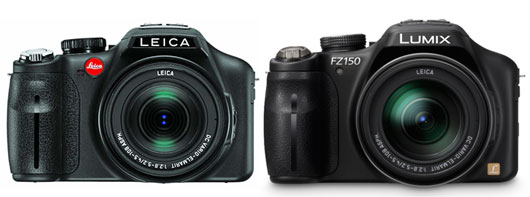
Leica V-LUX 3 vs Panasonic Lumix FZ150, Leica V-Lux 3 is actually just Leica’s version of the Panasonic Lumix DMC-FZ150 or they are really different?, read the comparison review of Leica V-LUX 3 with Panasonic Lumix FZ150 and share your thought with us,
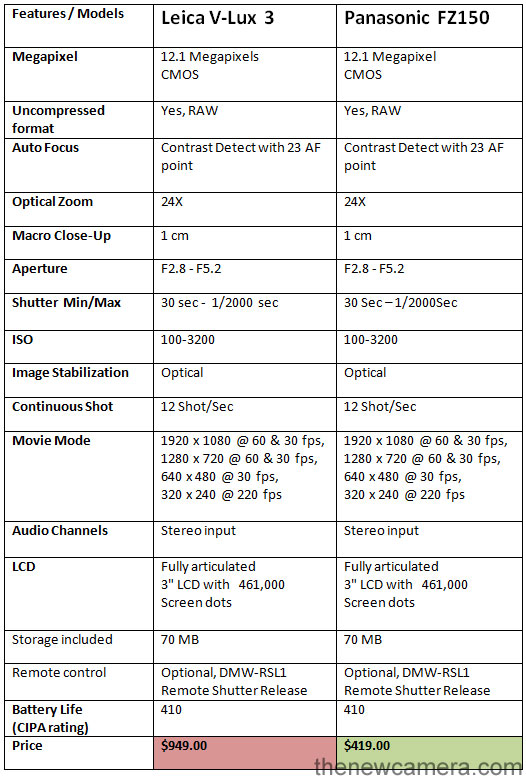
Both the camera have same core specification and even the battery life, Leica made only a few minor cosmetic changes here, obviously re-branding the camera with its logo, as well as changing the colors of the dials and due to cosmetic changes done by Leica the V-Lux 3 is 12gm more heavier than the FZ150, The big difference here, aside from price, the Leica V-Lux 3 comes with extended warranty and bundled software. V-Lux 3, customers will get Photoshop Elements, for image editing, and Premiere Elements, for video editing and after you register your product in Leica Camera Web site you get few more software free to download.
Buy Panasonic FZ150 from Amazon || Adorama || B&H || Amazon UK
Buy Leica V-Lux 3 from Amazon
|
KEEP THIS BLOG ALIVE - Support New Camera Buy Canon Lenses, Buy Music CD or Digital Camera at amazon it helps this site, and you do not pay anything extra, it is just a way to help support this site.

|
 Read the Canon G1 X vs. Nikon V1 vs. Panasonic GX1 review to find out the best camera for you.
Read the Canon G1 X vs. Nikon V1 vs. Panasonic GX1 review to find out the best camera for you.


















